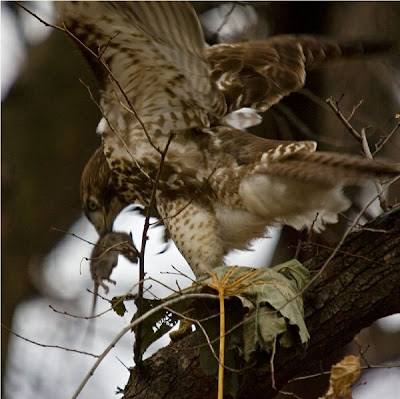
Photograph by Francois Portmann www.fotoportmann.com/
Photographer and Hawkwatcher Francois Portmann, managed to find and photograph both the Thompkins Square Park Brown-tails.

Photograph by Francois Portmann
Francois believes the hawk with the heavy belly band, above and in the next three photographs is a female.

Photograph by Francois Portmann
He reports that she's larger than the other bird. On a previous sighting this bird was perched in the park while the other, who seems fond of pigeon hunting, flew over. She called to him.

Photograph by Francois Portmann
She looks to be quite a dark bird, rather like Charlotte or Norman. Who, where many hawks are cream or white, these birds are more beige.

Photograph by Francois Portmann
Though as she's caught a rat, perhaps part of the dark effect may have to do with the time of day.

Photograph by Francois Portmann
This bird, Francois reports, is smaller than the first and likely a tiercel.

Photograph by Francois Portmann
True to his penchant for flushing pigeons, he does it again.

Photograph by Francois Portmann
To the railing he goes, with something in his crop already. He stares up, perhaps deciding how best to get one of those pigeons.

Photograph by Francois Portmann
I love this photograph. His posture makes him look like he is levitating in the way Rudolph Nuryev did during a leap. Though this guy does it as easily as breathing. Note the size of his toes and "ankle". Compare them with the Formel's in the photo of her that is fourth from the top.
I hope to see much more of these two.
RED-TAIL HUNTING IN THE SNOW
James Blank who has contributed Turkey and Hawk photographs to the blog, unfortunately saw an interesting Red-tail incident the other day when he didn't have his camera with him. (Let that be a lesson to all of us.)
After the latest snowstorm save one, Mr. Blank saw a mature Red-tail sitting in a tree overlooking an open area quite near where a crew was taking a jackhammer to frozen ground, looking for some cable or other. Red-tails being very patient when they feel they have the prospect of a good thing, sat there for some time. Then suddenly the hawk swooped out of the tree and toward the ground to make a grab. Her talons went down, there was a great puff of snow, the talons came up empty, she then did a three or four contact hopping motion and finally came up with a good sized rodent for her lunch. Which she flew away with to eat in peace.
An experienced hawk, she no doubt knew that excavation equipment tends to send rodents out of their burrows and was waiting for that to happen. But on that day, there was quite a number of inches of snow on the ground so did the rodent appear above the snow so the hawk could see it and then catch it? Or can hawks as owls do, listen for prey under snow and then make sightless grabs through that snow?
I'll ask John Blakeman.
Donegal Browne
P.S. Mr. Portmann wrote that he did see a downtown hawk collect a London Plane fruit. The fruits of the London Plane are about half the size of a Sycamore fruit but also have the fluff inside them. No more details on this as yet but I've asked.












































